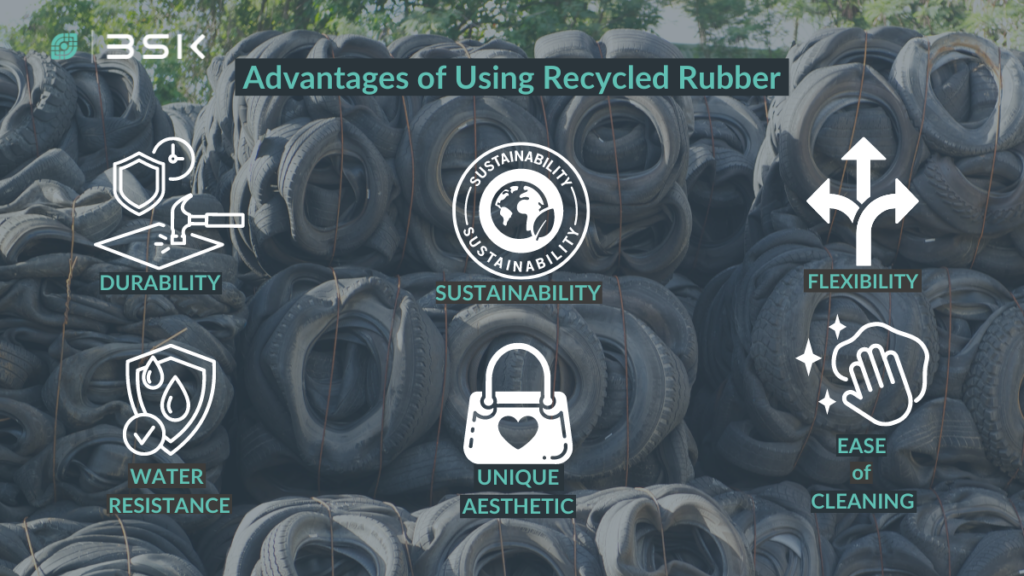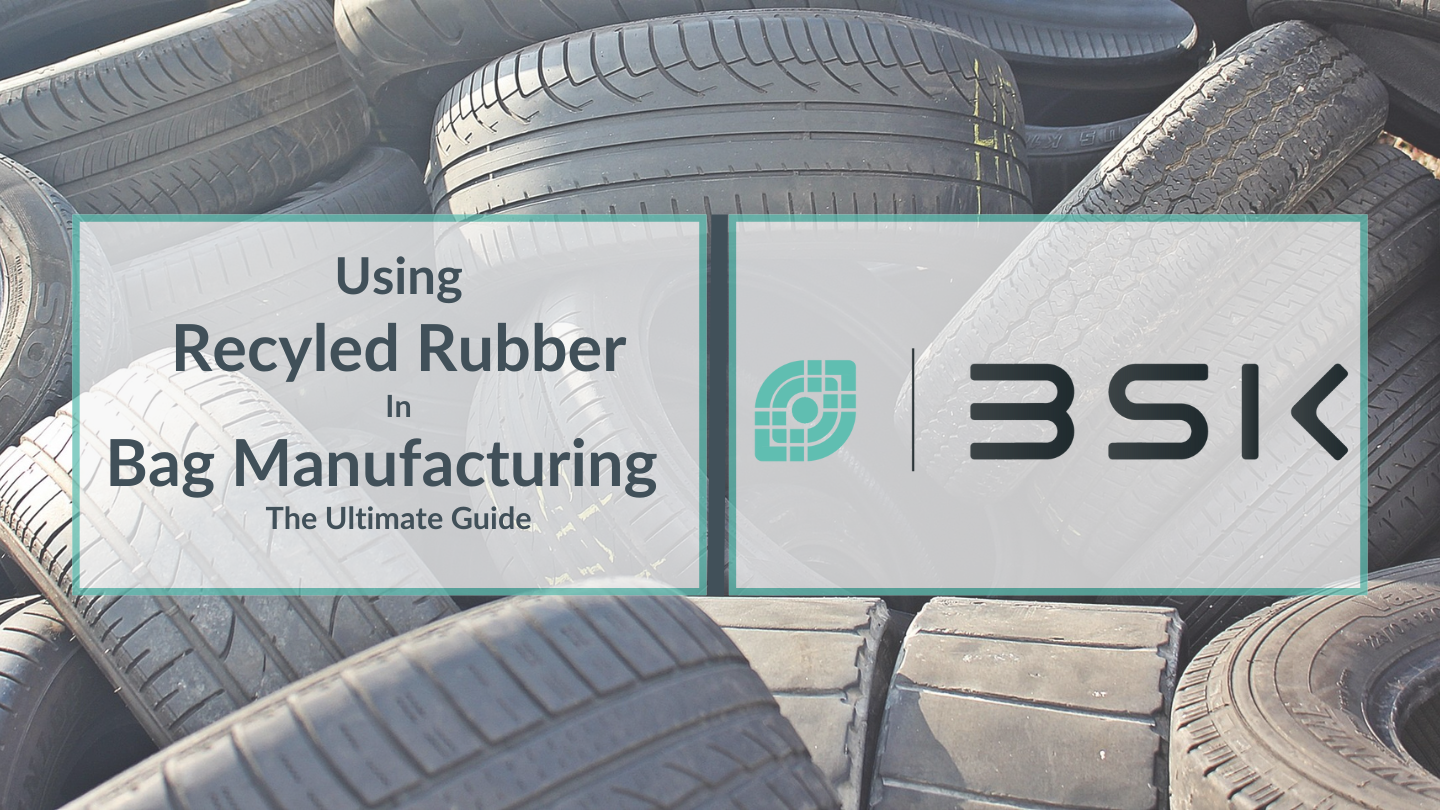Using recycled rubber in bag manufacturing has been a longstanding practice. Notably, the integration of recycled materials in fashion experienced a substantial increase during the 1990s and 2000s. Reflecting the growing consumer preference for sustainable and environmentally conscious products. In the 2010s, recycled rubber in fashion, including bags, gained widespread acceptance among brands and designers.
Revolutionizing Eco-Friendly Fashion with Recycled Rubber
Recycled rubber, sourced from old tires and various rubber products, is known for its durability, elasticity, water, and wear resistance. These features highlight it as an outstanding choice for creating a wide range of items, particularly in bag manufacturing. Recycled rubber bags are perfect for outdoor adventures, travel, and sports activities due to their environmentally friendly nature and robustness. Its flexibility, coupled with a shock-absorbing quality, offers superior protection for the contents inside. At the same time, its waterproof properties guarantee the safe transportation of items under any weather conditions. In manufacturing protective laptop sleeves, travel bags, sports and gym bags, waterproof backpacks, and tote bags, recycled rubber certainly has its place in bag manufacturing. Designers favor this material for its tactile appeal and role in promoting sustainability and innovation in product design.

Advantages of Using Recycled Materials
Using recycled rubber from tires for bag production contributes to environmental sustainability and offers unique benefits to consumers. Here’s a look at the key advantages and specific features that make recycled rubber particularly suitable for certain bags.
Durability: Recycled rubber is highly durable and resistant to tearing. It can withstand harsh weather conditions, making it an excellent material for travel bags, backpacks, and outdoor gear. The inherent strength of tire rubber ensures that bags can carry heavy loads without sustaining damage.
Water Resistance: The naturally water-resistant characteristics of rubber protect against rain and spills. Bags made from recycled tires are ideal for outdoor activities such as hiking and camping, ensuring the contents stay dry.
Sustainability: Utilizing recycled tires for bag production significantly reduces landfill waste and helps conserve natural resources. This approach aligns with the growing consumer demand for eco-friendly products and contributes to a circular economy.
Unique Aesthetic: Bags crafted from recycled rubber boast a distinct, rugged look that appeals to consumers seeking unique and statement pieces. The texture and patterns from the tire treads can add an intriguing design element to the products.
Cost-Effectiveness: Recycling tires into bags can be more economical than sourcing new materials, which helps reduce production costs. This enables the offering of environmentally friendly products at competitive prices.
Suitable for Certain Bags
Flexibility: Despite its inherent durability, recycled rubber can be quite flexible, making it suitable for sports and gym bags that need to adapt to various shapes and sizes of equipment.
Ease of Cleaning: The smooth surface of the rubber is easy to clean and maintain, an advantageous property for diaper bags, lunch bags, and other types that require frequent cleaning.
Limitations Using Recycled Materials
Using recycled rubber to manufacture bags presents an innovative approach to sustainability, yet we must address a variety of limitations and challenges. This complex issue encompasses various aspects, such as durability, cost, environmental impact, and maintenance requirements.
Durability and Flexibility Challenges
Recycled rubber’s durability indeed presents a double-edged sword. On the one hand, its ability to withstand wear and tear positions it as an ideal material for products that endure heavy use, such as floor mats and tires. However, its inherent stiffness and weight can be less than suitable for items like bags, which benefit from flexibility and lightweight properties for everyday use. This is precisely why many bag makers combine recycled rubber with other materials, such as nylon and cotton, in their products. By doing so, they can leverage the durability of recycled rubber while ensuring the bags remain practical for daily use, striking a balance between strength and user-friendliness.
Cost Implications
Converting recycled rubber into a usable form for bag manufacturing could entail additional costs. As mentioned, processing rubber to remove contaminants and ensure it’s wire-free can be resource-intensive. This, combined with the cost of designing functional and fashionable bags, might make recycled rubber bags more expensive than those made with traditional materials.
Environmental Impact of Using Recycled Materials
While significantly reducing the environmental footprint by repurposing waste materials, the production process can raise concerns. The energy consumption and emissions associated with processing rubber for secondary use must be evaluated. Additionally, end-of-life considerations for recycled rubber products can pose challenges if they’re not biodegradable or recyclable.
Maintenance Requirements for Recycled Material
Bags made from recycled rubber may require specific care to maintain appearance and functionality, which might be more complex than materials like fabric or leather. Users may find the need for specialized cleaning products or methods cumbersome.
To address the limitations of using recycled rubber in bag manufacturing, various strategies can be employed. These include blending recycled rubber with other sustainable materials to enhance flexibility and weight, leveraging creative design features like adjustable straps to improve functionality, exploring alternative materials like recycled plastics or organic cotton for better durability and environmental impact, and increasing consumer education on the benefits and sustainability of recycled rubber products. By implementing these suggestions, manufacturers can improve the practicality and market appeal of recycled rubber bags, contributing positively to both industry and environmental sustainability.
Manufacturing and Production Considerations
The manufacturing and production process of incorporating recycled rubber into the bag industry is initiated by gathering used rubber products, such as tires. Workers then sort, clean, and shred these items into smaller pieces. Following this, they grind the rubber into fine granules or powder. They then blend this material with binders and additional additives to improve its characteristics. Next, they heat and mold the mixture into the desired shapes using compression molding or extrusion techniques. Finally, the recycled rubber items undergo curing or vulcanization to enhance their durability and flexibility.
Sustainability and Environmental Impact Using Recycled Material
The sustainability of recycled rubber comes from its ability to reduce waste and conserve natural resources. Unlike traditional raw materials, which rely on finite natural resources, recycled rubber repurposes used materials, diverting them from landfills and reducing the demand for new raw materials. Though not biodegradable, it is highly durable and can be recycled multiple times, minimizing environmental impact.
Recycled materials often meet various eco-friendly certifications and industry standards, such as Cradle to Cradle, Global Recycled Standard (GRS), and ISO 14001. These certifications ensure that the material is produced and processed in environmentally responsible ways, following strict guidelines for sustainability.
Using recycled materials aligns well with current environmental concerns and trends, such as reducing carbon footprints, promoting circular economies, and supporting zero-waste initiatives. As consumers and industries push for more sustainable practices, recycled materials stand out as a viable option for eco-conscious manufacturing.
Industry Reveleance Using Recycled Material
To conclude, integrating recycled materials into bag manufacturing highlights a significant shift towards sustainable fashion, combining durability, water resistance, and eco-friendliness. While offering unique aesthetic and cost benefits, challenges such as flexibility and processing costs do exist. However, the material’s advantages, particularly in promoting environmental sustainability and innovation in design, make it a compelling choice for those in the bag-making industry. Encouraging both manufacturers and consumers to consider recycled rubber’s potential demonstrates a forward-thinking approach to eco-conscious production and consumption.
